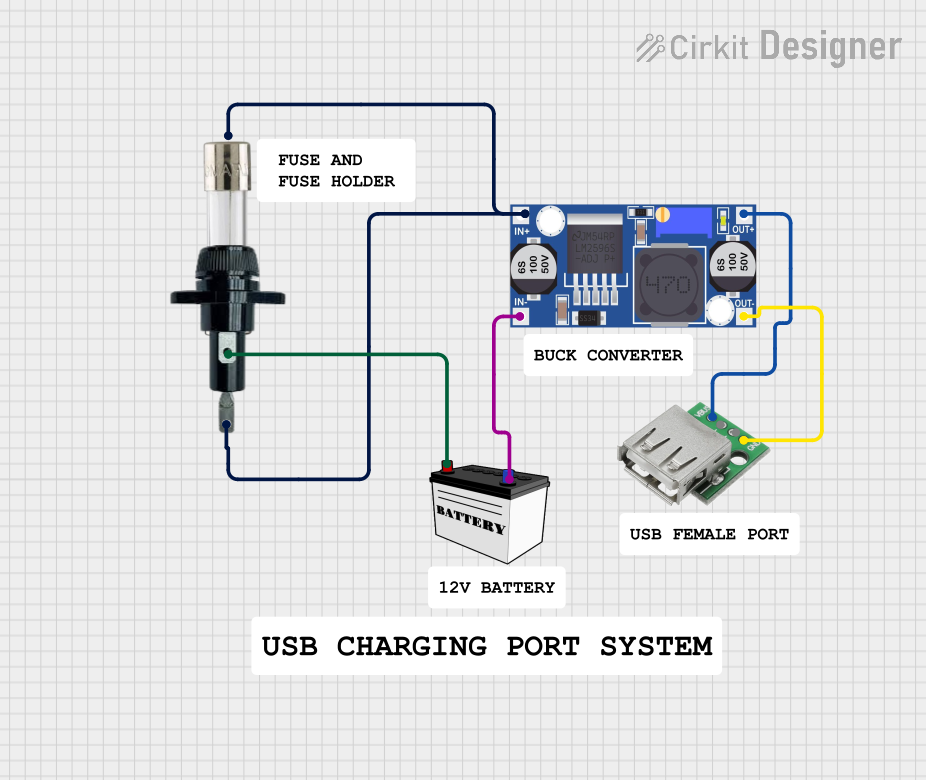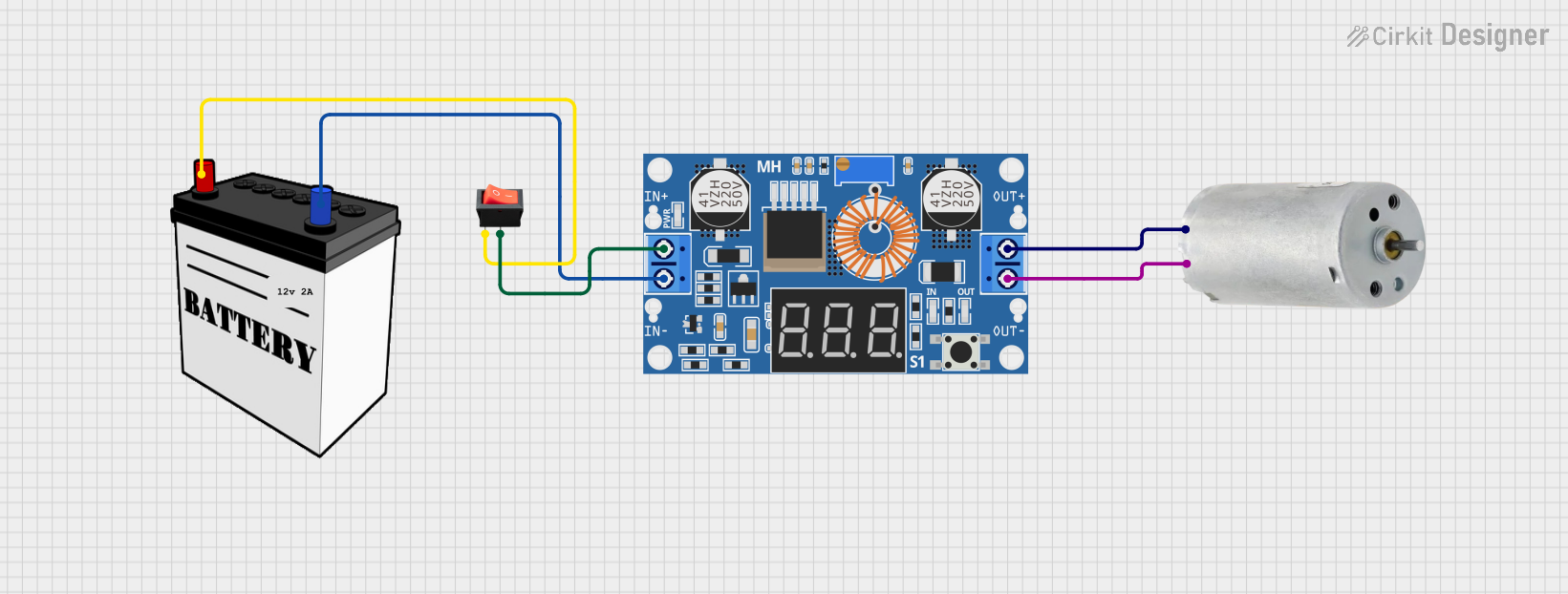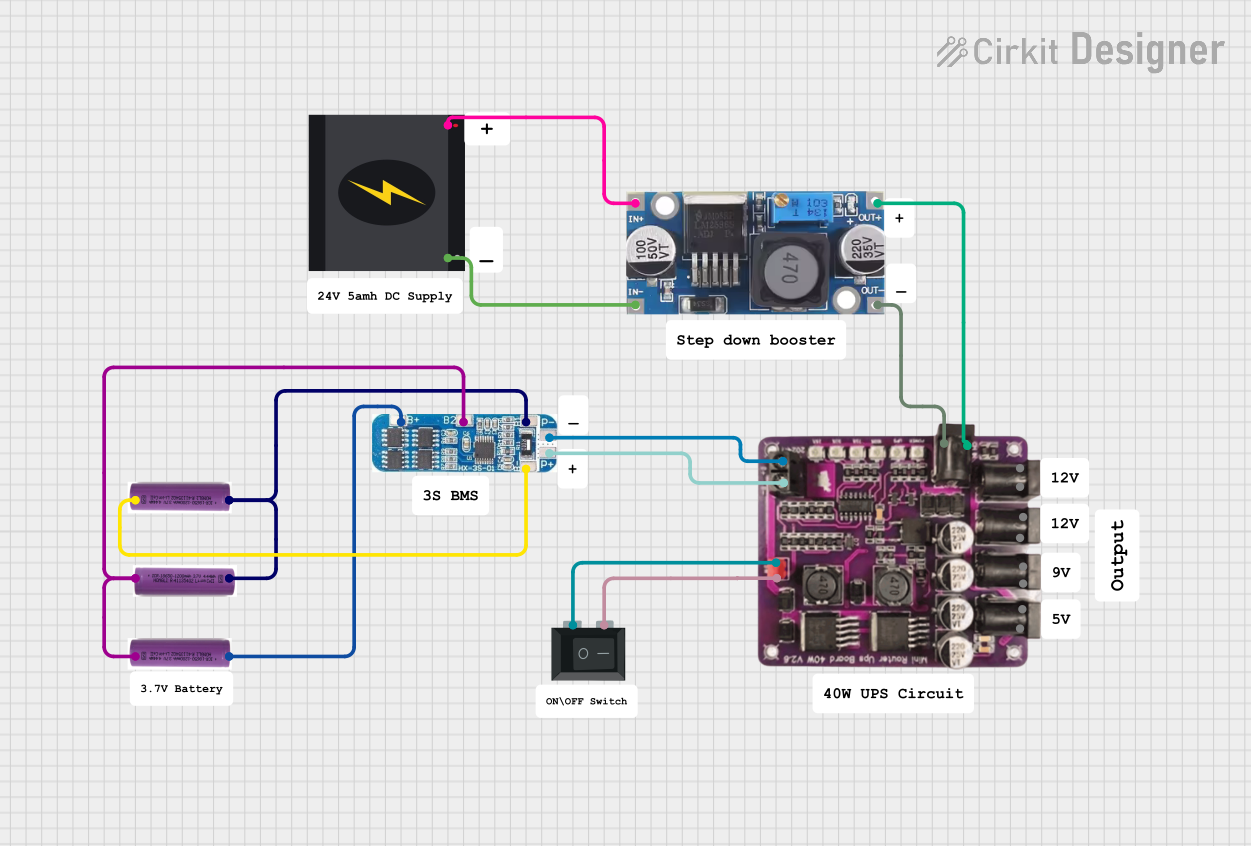
Cirkit Designer
Your all-in-one circuit design IDE
Home /
Component Documentation
How to Use 24-12V to 5V DC-DC Step Down (Buck) Converter (5A): Examples, Pinouts, and Specs

 Design with 24-12V to 5V DC-DC Step Down (Buck) Converter (5A) in Cirkit Designer
Design with 24-12V to 5V DC-DC Step Down (Buck) Converter (5A) in Cirkit DesignerIntroduction
The Daygreen 24-12V to 5V DC-DC Step Down (Buck) Converter is a high-efficiency voltage regulator designed to step down input voltages ranging from 12V to 24V to a stable 5V output. With a maximum output current of 5A, this converter is ideal for powering low-voltage devices such as microcontrollers, sensors, and USB-powered devices from higher voltage sources like car batteries, solar panels, or industrial power supplies.
Explore Projects Built with 24-12V to 5V DC-DC Step Down (Buck) Converter (5A)
USB Power Supply with Overcurrent Protection

This circuit is designed to step down voltage from a 12V battery to a lower voltage suitable for USB devices. It includes a buck converter connected to the battery through a fuse and fuse holder for overcurrent protection. The output of the buck converter is connected to a USB female port, providing a regulated power supply for USB-powered devices.
 Open Project in Cirkit Designer
Open Project in Cirkit DesignerBattery-Powered DC-DC Converter System for Multi-Voltage Power Distribution

This circuit converts a 38.5V battery output to multiple lower voltage levels using a series of DC-DC converters and a power module. It includes an emergency stop switch for safety and distributes power to various components such as a relay module, USB ports, and a bus servo adaptor.
 Open Project in Cirkit Designer
Open Project in Cirkit DesignerBattery-Powered DC Generator with XL4015 Buck Converter

This circuit consists of a 12V battery connected to a rocker switch, which controls the input to an XL4015 DC Buck Step-down converter. The converter steps down the voltage to power a DC generator, with the generator's output connected back to the converter to form a feedback loop.
 Open Project in Cirkit Designer
Open Project in Cirkit DesignerBattery-Powered UPS with Step-Down Buck Converter and BMS

This circuit is a power management system that steps down a 240V AC input to a lower DC voltage using a buck converter, which then powers a 40W UPS. The UPS is controlled by a rocker switch and is backed up by a battery management system (BMS) connected to three 3.7V batteries in series, ensuring continuous power supply.
 Open Project in Cirkit Designer
Open Project in Cirkit DesignerExplore Projects Built with 24-12V to 5V DC-DC Step Down (Buck) Converter (5A)

USB Power Supply with Overcurrent Protection
This circuit is designed to step down voltage from a 12V battery to a lower voltage suitable for USB devices. It includes a buck converter connected to the battery through a fuse and fuse holder for overcurrent protection. The output of the buck converter is connected to a USB female port, providing a regulated power supply for USB-powered devices.
 Open Project in Cirkit Designer
Open Project in Cirkit Designer
Battery-Powered DC-DC Converter System for Multi-Voltage Power Distribution
This circuit converts a 38.5V battery output to multiple lower voltage levels using a series of DC-DC converters and a power module. It includes an emergency stop switch for safety and distributes power to various components such as a relay module, USB ports, and a bus servo adaptor.
 Open Project in Cirkit Designer
Open Project in Cirkit Designer
Battery-Powered DC Generator with XL4015 Buck Converter
This circuit consists of a 12V battery connected to a rocker switch, which controls the input to an XL4015 DC Buck Step-down converter. The converter steps down the voltage to power a DC generator, with the generator's output connected back to the converter to form a feedback loop.
 Open Project in Cirkit Designer
Open Project in Cirkit Designer
Battery-Powered UPS with Step-Down Buck Converter and BMS
This circuit is a power management system that steps down a 240V AC input to a lower DC voltage using a buck converter, which then powers a 40W UPS. The UPS is controlled by a rocker switch and is backed up by a battery management system (BMS) connected to three 3.7V batteries in series, ensuring continuous power supply.
 Open Project in Cirkit Designer
Open Project in Cirkit DesignerCommon Applications
- Powering microcontrollers (e.g., Arduino, Raspberry Pi) and sensors
- USB device charging (e.g., smartphones, tablets)
- Automotive electronics
- Industrial control systems
- Renewable energy systems (e.g., solar-powered devices)
Technical Specifications
Key Specifications
| Parameter | Value |
|---|---|
| Input Voltage Range | 12V to 24V DC |
| Output Voltage | 5V DC |
| Maximum Output Current | 5A |
| Efficiency | Up to 95% |
| Operating Temperature | -40°C to +85°C |
| Dimensions | Varies by model (compact size) |
| Manufacturer | Daygreen |
Pin Configuration and Descriptions
| Pin Name | Description |
|---|---|
| VIN+ | Positive input voltage (12V to 24V DC) |
| VIN- | Negative input voltage (ground) |
| VOUT+ | Positive output voltage (5V DC) |
| VOUT- | Negative output voltage (ground) |
Usage Instructions
How to Use the Component in a Circuit
- Connect the Input Voltage:
- Connect the positive terminal of your power source (12V to 24V DC) to the
VIN+pin. - Connect the negative terminal of your power source to the
VIN-pin.
- Connect the positive terminal of your power source (12V to 24V DC) to the
- Connect the Output Load:
- Connect the positive terminal of your load (e.g., microcontroller, USB device) to the
VOUT+pin. - Connect the negative terminal of your load to the
VOUT-pin.
- Connect the positive terminal of your load (e.g., microcontroller, USB device) to the
- Verify Connections:
- Double-check all connections to ensure proper polarity and secure wiring.
- Power On:
- Turn on the input power source. The converter will regulate the input voltage to a stable 5V output.
Important Considerations and Best Practices
- Heat Dissipation: At high currents (close to 5A), the converter may generate heat. Ensure adequate ventilation or use a heatsink if necessary.
- Input Voltage Range: Do not exceed the specified input voltage range (12V to 24V DC) to avoid damaging the converter.
- Load Requirements: Ensure the connected load does not exceed the maximum output current of 5A.
- Polarity Protection: Double-check the polarity of input and output connections to prevent damage to the converter or connected devices.
Example: Using with an Arduino UNO
The Daygreen DC-DC Step Down Converter can be used to power an Arduino UNO from a 12V car battery. Below is an example wiring and code:
Wiring Diagram
- Connect the car battery's positive terminal to
VIN+and negative terminal toVIN-. - Connect the
VOUT+pin to the Arduino UNO's 5V pin. - Connect the
VOUT-pin to the Arduino UNO's GND pin.
Example Code
// Example code to blink an LED on pin 13 of the Arduino UNO
// Ensure the Arduino is powered via the 5V output of the DC-DC converter
void setup() {
pinMode(13, OUTPUT); // Set pin 13 as an output
}
void loop() {
digitalWrite(13, HIGH); // Turn the LED on
delay(1000); // Wait for 1 second
digitalWrite(13, LOW); // Turn the LED off
delay(1000); // Wait for 1 second
}
Troubleshooting and FAQs
Common Issues and Solutions
| Issue | Possible Cause | Solution |
|---|---|---|
| No output voltage | Incorrect wiring or loose connections | Verify all connections and polarity. |
| Output voltage is unstable | Input voltage is outside the range | Ensure input voltage is between 12V-24V. |
| Converter overheats | Excessive load or poor ventilation | Reduce load or improve heat dissipation. |
| Connected device not powering on | Load exceeds 5A or wiring issue | Check load requirements and connections. |
FAQs
- Can I use this converter with a 9V input?
- No, the input voltage must be within the specified range of 12V to 24V DC.
- What happens if I exceed the 5A output current?
- Exceeding 5A may cause the converter to overheat, shut down, or become damaged.
- Is the converter waterproof?
- No, the converter is not waterproof. Use it in a dry environment or enclose it in a waterproof case if necessary.
By following this documentation, you can safely and effectively use the Daygreen 24-12V to 5V DC-DC Step Down (Buck) Converter in your projects.